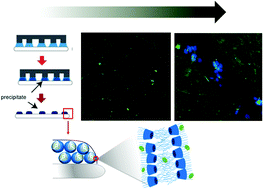Amphiphilic cationic cyclodextrin nanovesicles: a versatile cue for guiding cell adhesion†
Abstract
It is well known that amphiphilic cationic β-cyclodextrins (amβCDs) form nanovesicles able to release their cargo in aqueous solution upon applying different stimuli. In addition they can be selectively positioned onto substrates by unconventional soft lithography. This makes them a powerful tool for designing environments where different cues can be externally supplied to the cells helping to achieve good control of their fate. Lithographically controlled wetting (LCW) of amβCD nanovesicles loaded with fluorescein isothiocyanate (FITC), amβCD/FITC, has been used here to fabricate geometrically functionalized surfaces, thus achieving multiscale control of the cell environment. The amβCD functionalization was strongly influenced by the surface energy of the underlying substrates that, according to their hydrophobicity, orient the amβCD in a different way, thus “offering” different portions to the cells. The structure of the pattern was characterized both over large scales exploiting the FITC fluorescence and at the nanoscale by atomic force microscopy. Cell guidance and aCD/FITC cell internalization were demonstrated in human neuroblastoma SHSY5Y cells.



 Please wait while we load your content...
Please wait while we load your content...